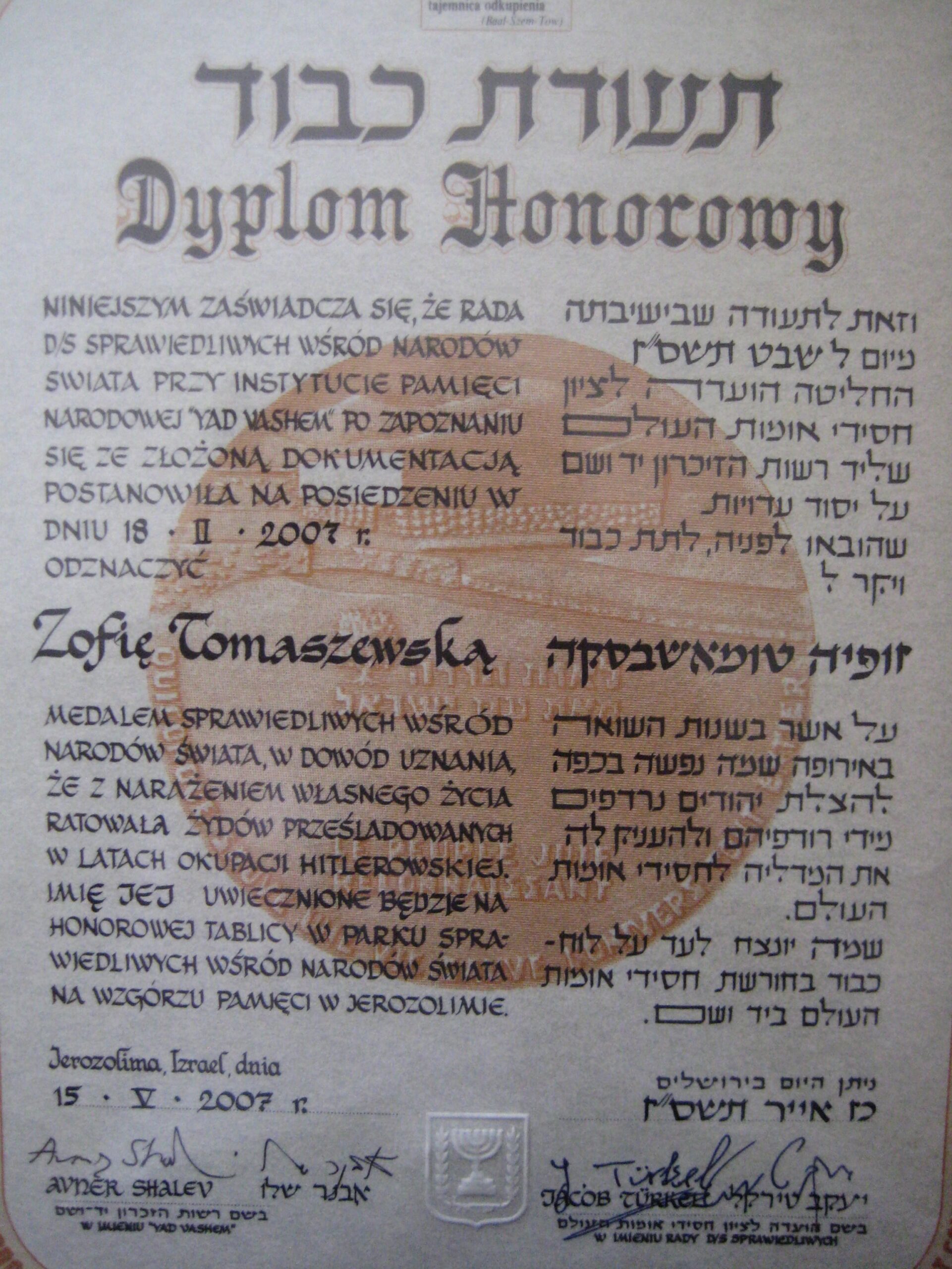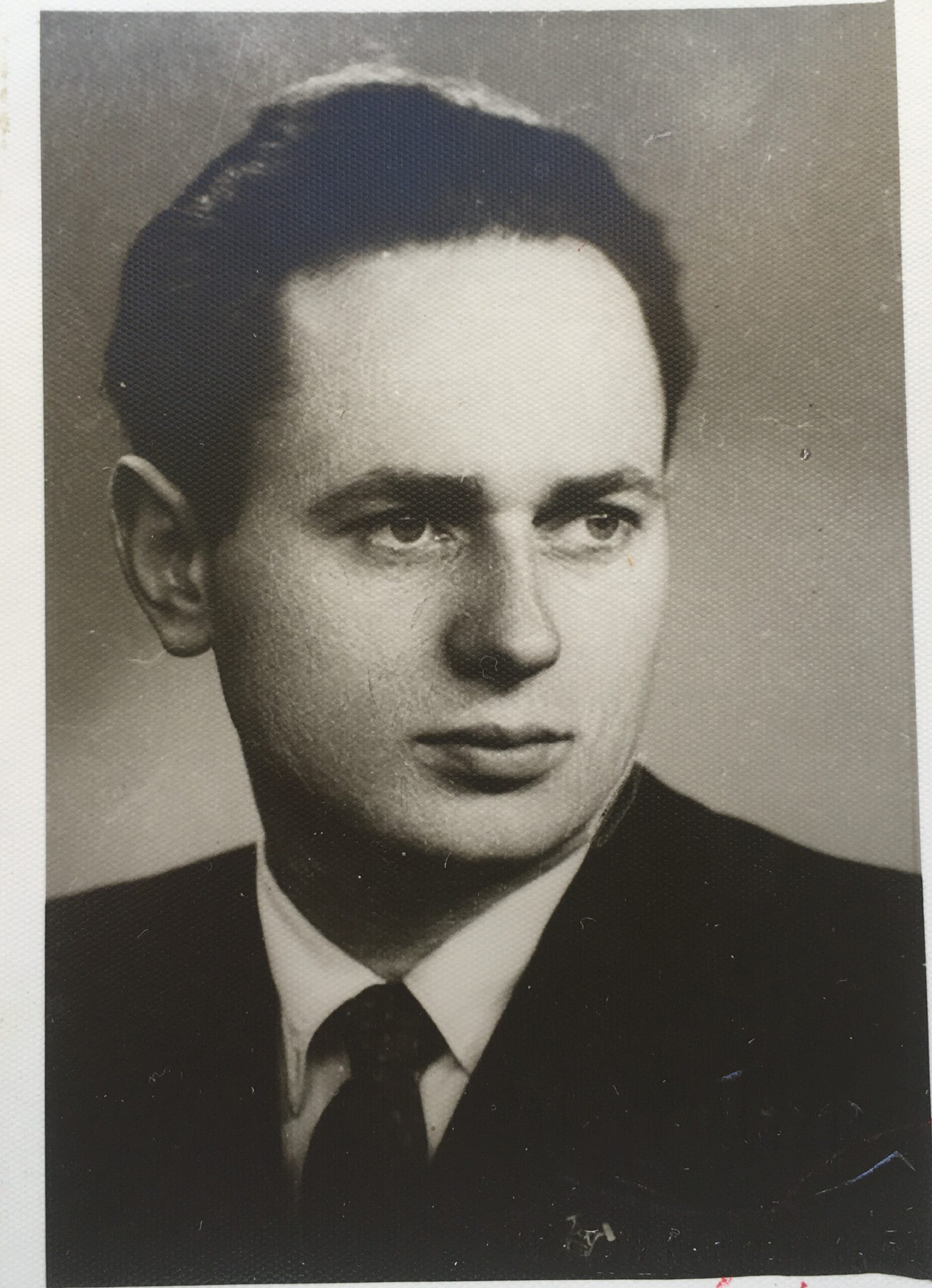Janusz Maria Tomaszewski

The "Save the Memory" project is a series of video interviews with witnesses of history from 1939- 1956. It was created to preserve the memories and experiences of the heroes and heroines from this period.
Na początku i na końcu filmu na czarnej planszy pojawiają się biały logotyp Muzeum Krakowa i adres strony www.ocalicpamiec.muzeumkrakowa.pl oraz data nagrania filmu – 2020. Następnie pojawia się informacja o bohaterze – Januszu Tomaszewskim, który jest synem Zofii Tomaszewskiej, Sprawiedliwej Wśród Narodów Świata.
Bohaterem filmu jest Janusz Maria Tomaszewski. Urodził się w 1931 w Krakowie. Syn Wacława – urzędnika dyrekcji kolei i nauczycielki Zofii z domu Reyman. W jego domu podczas wojny ukrywała się żydowska rodzina Rubachów. Starszy mężczyzna, ma siwe włosy i łagodny owal twarzy. Ubrany jest w szarą koszulę, ciemną marynarkę i okulary. Kadr ukazuje go ujętego do ramion. Tłem jest brązowa kotara. W trakcie filmu pokazuje pamiątki rodzinne oraz dokumenty.
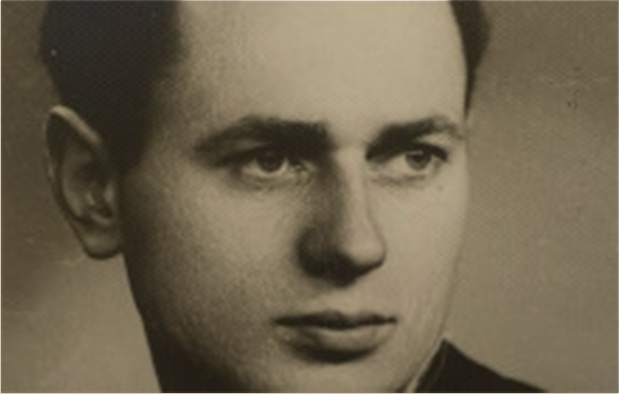
Janusz Maria Tomaszewski
1931

Black and white portrait photograph of Janusz Tomaszewski. The man has a prominent forehead, dark hair, and low-set eyebrows. He is dressed in a black suit, white shirt, and dark tie.
Janusz Maria Tomaszewski (born 10 December 1931, Kraków). Son of Wacław Bończa Tomaszewski (1900-1971), a railroad management official, and Zofia (1900-1982) née Reyman, a teacher. The Rubachs, a Jewish family, were hiding in his family home between 1942 and 1944.
The peaceful childhood of an only child, surrounded by a large and loving family, was interrupted by the war. In September 1939 Waclaw Tomaszewski, a railroad worker, was ordered to evacuate to the East; his wife and son accompanied him as they fled and lived a life on the run. The Tomaszewski family traveled to Minsk and it was only in spring 1940 that they returned to Kraków.
They settled in a tenement house in Jabłonowskich Street. The house had been built in 1893 by Janusz’s great-grandfather, Władysław Markiewicz. In 1932 the family sold the tenement house to the order of Sister Servants of the Most Sacred Heart of Jesus, keeping three out of six apartments.
When World War II broke out, Janusz Tomaszewski was almost 8 years old. Since his mother and three uncles were actively involved in the fight against the German invaders, his health and life were constantly in danger. He witnessed Gestapo searches at home, and listened to war stories told by his uncles, but also bore witness to his mother being involved in saving a Jewish family.
Already in November 1939, Zofia Tomaszewska was helping her youngest brother in his underground activities in Związek Walki Zbrojnej ZWZ (the Union for Armed Struggle); Jan Reyman (1902-1984) held a Ph.D. in chemistry and was a liaison officer of Major Jan Cichocki, code de guerre ‘Jaś’ (later promoted to Lieutenant Colonel, chief of staff of the ZWZ Area 4 Krakow Headquarters).
His mother’s eldest brother, Henryk Reyman (1897-1963), Lieutenant Colonel of the Polish Army, Olympic athlete, Wisła Kraków soccer player (the Municipal Stadium in Kraków now bears his name), escaped from German captivity. As further hiding in Kraków became increasingly dangerous, in the summer of 1940 Zofia Tomaszewska, using her husband’s documents, took Henryk to the Tarnobrzeg estate of the Tarnowskis. Henryk Reyman was hiding there as a gamekeeper until the end of the war.
On 21 February 1941, another uncle of Janusz Tomaszewski, Stefan Reyman (1898-1941) was arrested in the U Literatów cafe. He was murdered in Auschwitz concentration camp on 1 August 1941.
On 27 May 1942, Jan Reyman was arrested in his family home. On 6 June 1942, he was deported to Auschwitz concentration camp. He survived the camp and returned to Kraków after 1945.
In such a dramatic turn of events for the family, in the summer of 1942, a Turk named Nazmi Korchan showed up at the Tomaszewski family home to rent a room for his family. He was the owner of a pastry shop in Włocławek which he had established at the end of 1938. He had fallen in love with and married his customer, a Jewish woman named Dora Rubach.
When the town was incorporated into the Third Reich, the Rubach and Korchan family fled to Częstochowa in the General Government (GG). In April 1941, just before the ghetto was closed, Dora’s sister Genia with her two sons (her husband Józef had been killed during the defense war[1] in 1939) escaped from the ghetto. They took refuge in an apartment above the Korchans’ confectionery store. Nazmi Korchan not only sought a new identity and fake documents at the Turkish embassy for Genia and her sons, but for security reasons, he found a place at the Tomaszewski family’s home in Kraków for his sister-in-law, and officially for his wife and sons.
As Turkish citizens, they were relatively safe in the GG, because Turkey was a neutral state under the German-Turkish Treaty of Friendship and non-aggression pact signed in June 1941 with the Third Reich.
And so they lived in a room that stood vacant after Jan Reyman’s arrest, claiming to be Turks and under false names: Tamara Korchan (actually Genia Rubach) and her sons: 10-year-old Ahmed called Ula (actually Leon Rubach, 1932-2017) and 4-year-old Megid (actually Marek[2]). The following year they were joined by Nazmi’s actual wife, Dora Korchan née Rubach, and her daughter, Zaida.
Zofia Tomaszewska suspected right from the beginning that the young women and their children were Jews, but for over two years she turned a blind eye and did nothing to get rid of the dangerous tenants. She allowed her son to make friends with the older boy. They not only played together but also worked together. Ula persuaded Janusz to work, the boys offered their assistance to the shoppers at the market on Szczepanski Square in delivering purchases, e.g. Christmas trees before Christmas.
In the summer of 1944, as a result of a denunciation, the Gestapo came to the Tomaszewskis’ apartment. The tenants had gone to town, but Ula was playing with Janusz in the yard, practically right under Tomaszewski’s kitchen window.
The Gestapo decided to wait. They sat in the room of the alleged Turks and through the open door watched Zofia, bustling around in the kitchen. Knowing that the return of the tenants could mean death to both families, Zofia warned Ula while moving the washed dishes to the table next to the window.
Janusz Tomaszewski recalls: “Ula ran to the Planty Park and waited there for his mother and brother. The Gestapo officers never saw the tenants return and ordered [Zofia Tomaszewska] to report the next day to Pomorska Street to the Gestapo headquarters. Mom and the rest of us were saved by the fact that the Gestapo men had watched her closely all the time and yet did not notice her warn Ula. After the interrogation, Mom returned home in the evening.”
Zofia found shelter for the Rubachs at her friend, Felicia Menhard’s place, who lived at Planty Dietlowskie. After a few days, Zofia brought them some of their belongings. Soon afterwards both friends organized for the family to be transported to Pionki and Garbatka near Radom.
They all happily lived to see the end of the war and together they returned to Częstochowa. In 1946 they left for Paris, and then for Belgium. However, Nazmi Korchan returned to Poland. The Rubach sisters and their children, upon receiving a visa to the USA in 1952, left Europe forever.
During the occupation, Janusz Tomaszewski graduated from primary school, in 1948 from the gymnasium [middle high school], and 1950 from the 4th Henryk Sienkiewicz High School. He went on to obtain a Master’s degree in engineering at Akademia Górniczo – Hutnicza [University of Mining and Metallurgy, nowadays the University of Science and Technology], at the Faculty of Mechanization of Mining and Metallurgy. After a few years of assistantship at Akademia Górniczo – hutnicza, he started working in the railroad vocational training, where he remained active until his retirement.
Janusz Tomaszewski enjoys traveling. In 1961 he visited Bulgaria on a WK-125 motorbike, then he traveled across Europe, the Balkans, and Turkey in a Fiat 600. He also visited Israel and the United States. He tried to convey his interest in traveling to young people by organizing domestic and foreign camps and trips for them. For his achievements in teaching and educational work, he received several awards from the Minister of Education as well as the Gold Cross of Merit. In 2013, the General Assembly of the Wisła Sports Club granted him the title of Honorary Member for preserving the memory of the club’s outstanding sportsmen and making family memorabilia available for the exhibition dedicated to the memory of Henryk Reyman.
25 years after the death of Zofia Tomaszewska, on 15 May 2007, the Yad Vashem Institute awarded her with the title of Righteous Among the Nations. The ceremony took place in the High Synagogue in Kraków and the medal was accepted by her son, Janusz Tomaszewski.
In 2017 Zofia Tomaszewska was awarded the Jan Karski Courage to Care Award by the Anti-Defamation League in the USA for saving the Rubach family, which was received by Janusz’s son, Wojciech Tomaszewski.
Janusz Tomaszewski repeatedly asked himself why his mother had risked her own life and that of her loved ones. This question also came up during conversations with Leon (Ula) Rubach, the survivor. The answer has always been and remains unambiguous: “I admire the courage of my mother, who helped strangers – Jews; she knew that by helping she was putting herself and her whole family at risk. That help was selfless. The reason behind it was the compulsion to help people in need, and above all to save their lives. We maintained contact with Ula [Leon Rubach] until the end, in person or by phone, when he came to Poland, or when I visited my family in the United States.
In 1975 Genia Rubach sent Christmas wishes to the Tomaszewski family, which she concluded with the words: “I love you, Zosia”.
Can you express your gratitude for someone saving your life in any stronger manner? The Tomaszewski and Rubach families, living on two different continents, have stayed in touch to this very day.
Janusz Tomaszewski has three sons – Wojciech, Piotr, and Michał – as well as grandchildren and great-grandchildren. He continues to live in Kraków, in an apartment inhabited by the family for four generations.
Gallery
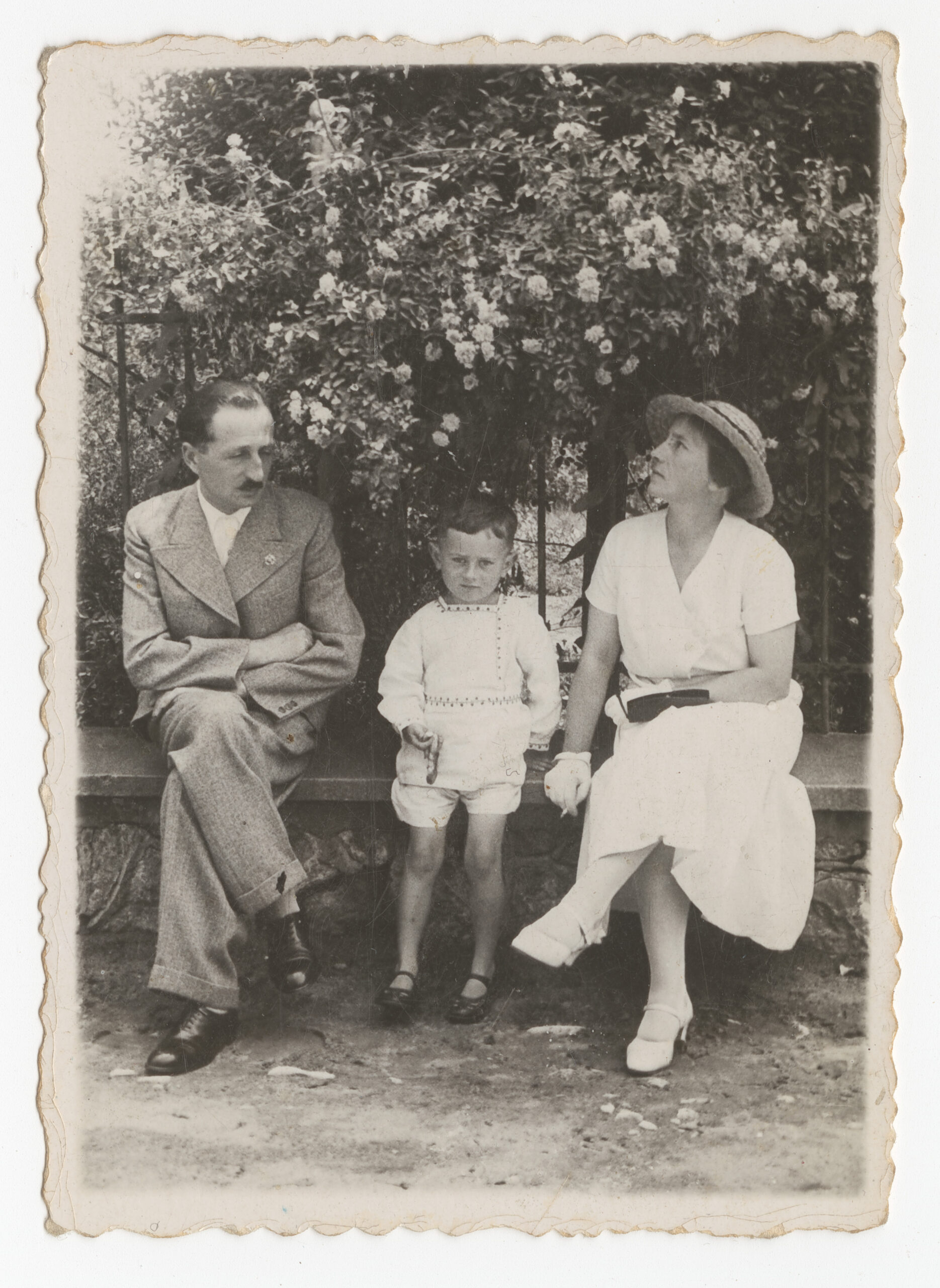
Janusz Tomaszewski with his parents, Zofia and Wacław, on Wawel Hill, 1936

Czarno-białe zdjęcie kilkuletniego Janusza Tomaszewskiego z rodzicami – Zofią i Wacławem, na Wawelu. Rodzina siedzi na ławce na tle ogrodzenie, na które opada kwitnąca gałąź. Rodzice są w średnim wieku. Mężczyzna ma ciemne wąsy i zaczesane do tyłu włosy. Ubrany jest w jasną marynarkę i czarne buty. Dziecko ma na sobie białą koszulę i krótkie spodenki. Kobieta ubrana jest w długą, białą sukienkę i rękawiczki, na głowie ma jasny kapelusz.
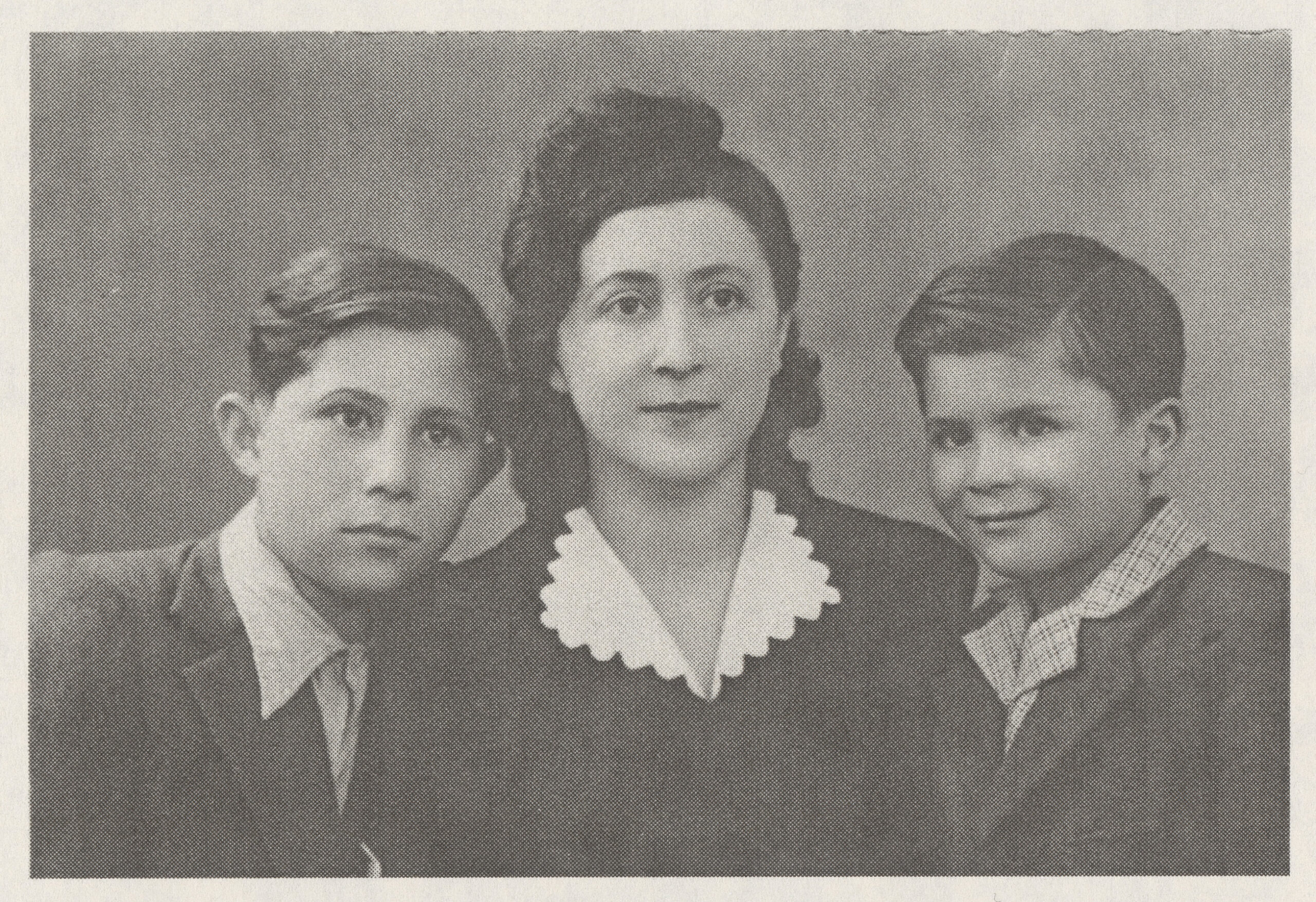
Leon Rubach with his mother Genia and brother Marek, Częstochowa, 1946. Leon Rubach, „The Autobiography of Leon Rubach. The First Twenty Years”, New Jersey 2009

Czarno-białe zdjęcie portretowe Leona Rubacha z mamą Gienią i bratem Markiem. Ujęcie do pasa. Chłopcy mają około dziesięciu lat. Ubrani są w ciemne marynarki i jasne koszule. Kobieta stoi pomiędzy synami. Ma ciemne, falowane włosy i wąskie usta, lekko się uśmiecha. Ubrana w czarną marynarkę z ozdobnym, białym kołnierzem.
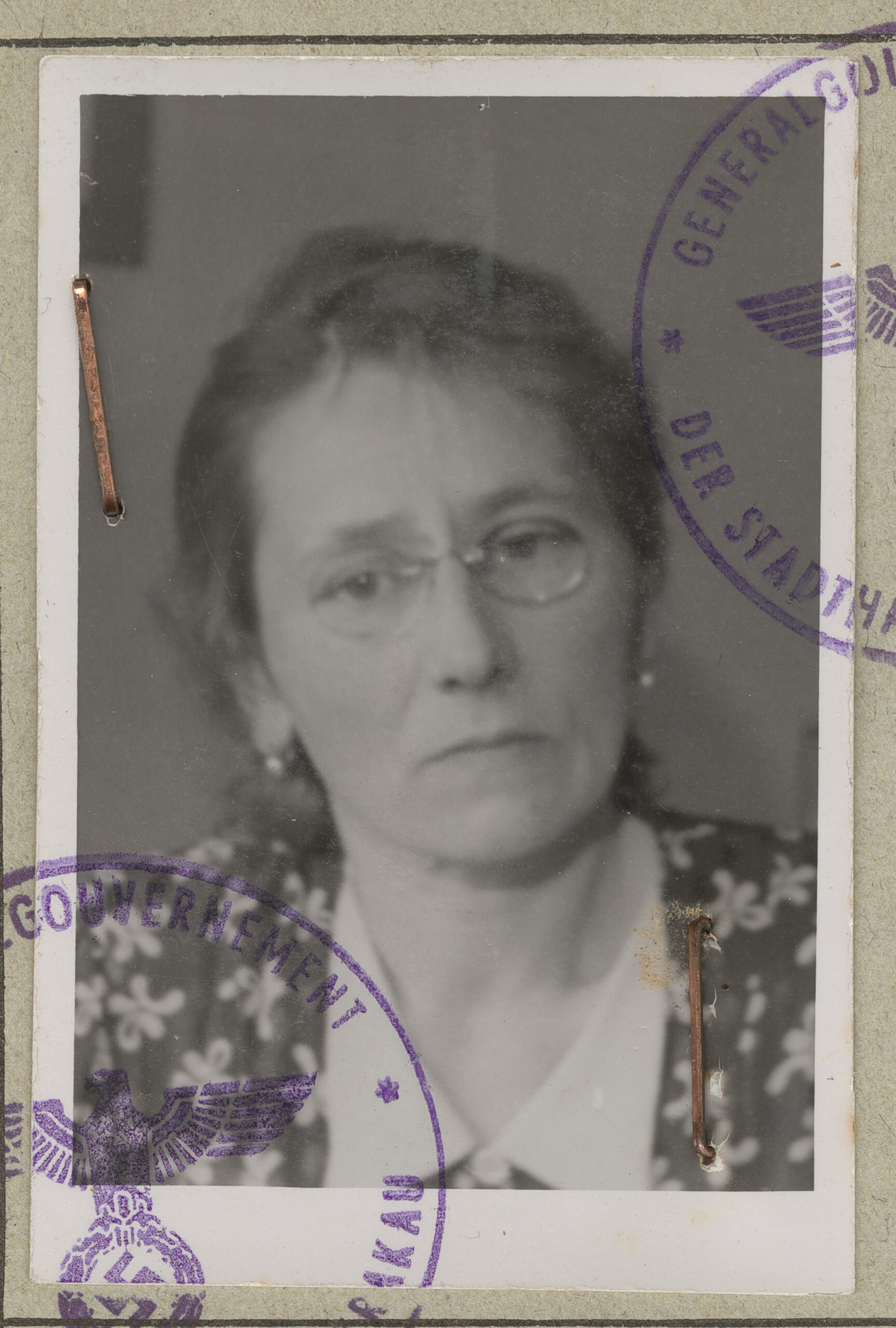
Zofia née Reyman Tomaszewska, Kraków, 1942

Czarno-białe zdjęcie portretowe do dokumentu czterdziestodwuletniej kobiety. Ujęcie do ramion. Ma ciemne, spięte włosy, wąskie usta, nosi kolczyki w uszach i okrągłe okulary. Ubrana jest w kwiecistą sukienkę z białym kołnierzem.
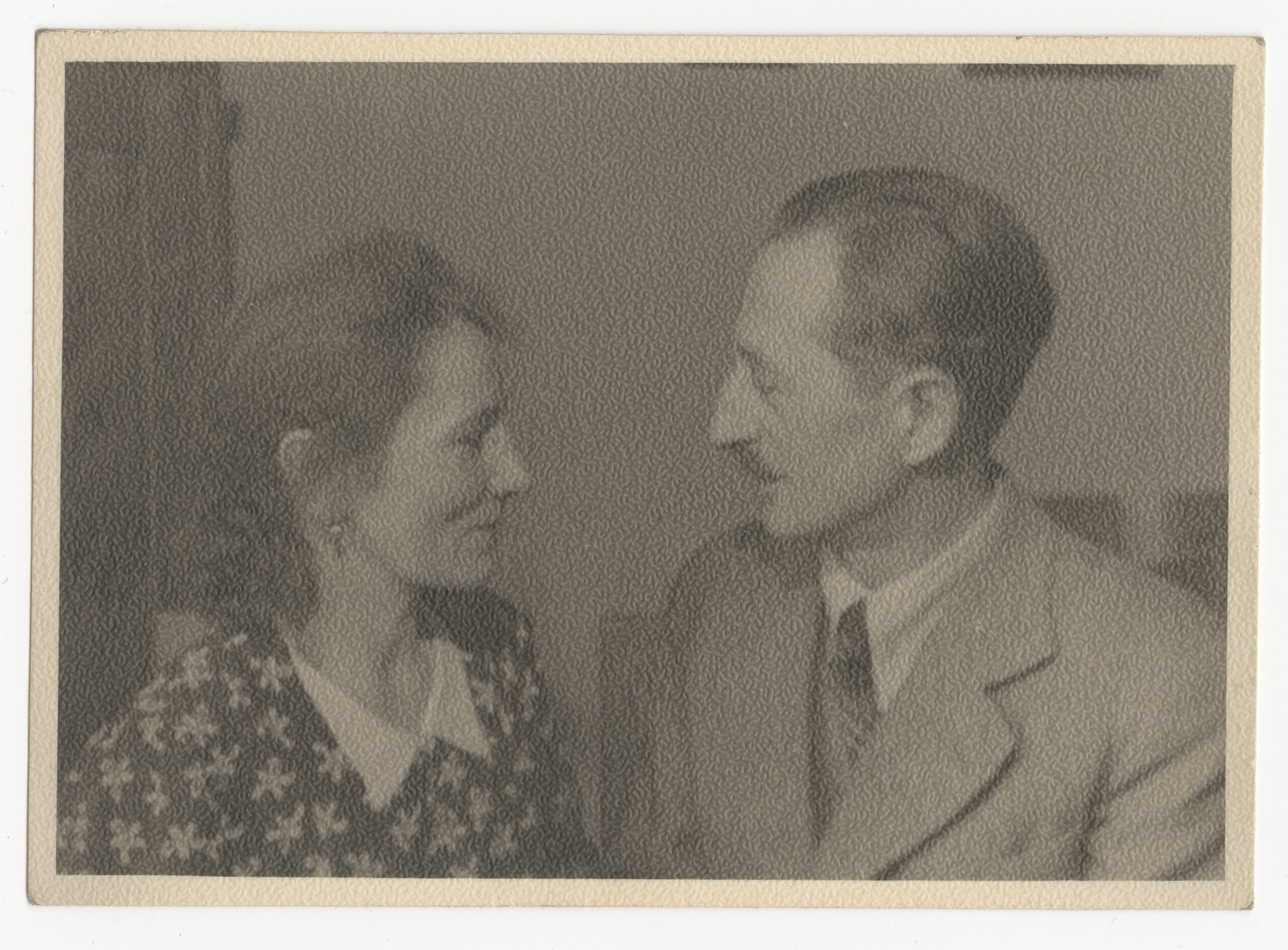
Zofia and Wacław Tomaszewski, in the 1960s

Czarno-białe zdjęcie portretowe z profilu, pary w średnim wieku, twarzami ku sobie. Kobieta ma kwiecistą sukienkę z białym kołnierzem, w uszach kolczyki. Mężczyzna ma wąsy, krótkie włosy zaczesane do tyłu, ubrany jest w jasny garnitur, białą koszulę i krawat, spogląda na kobietę z pogodnym wyrazem twarzy.
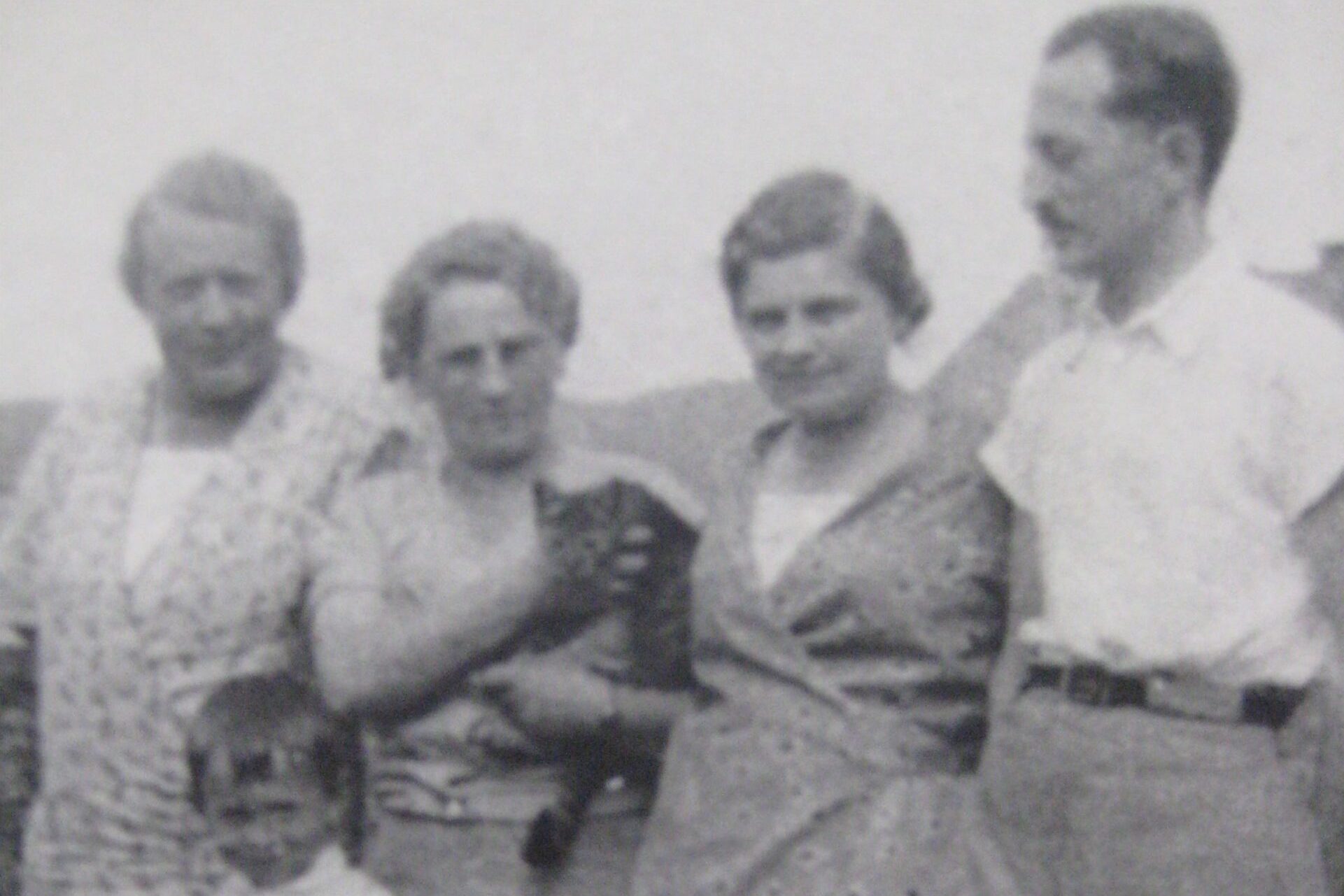
The Tomaszewski family with Zofia’s friend Felicja Menhard and her niece, Magda Piasecka

Czarno-białe zdjęcie grupy pięciu osób, trzech kobiet, mężczyzny i kilkuletniego chłopca. Kobiety mają falowane włosy do uszów z przedziałkiem z boku głowy. Ubrane są w długie, kwieciste sukienki z głębokimi dekoltami w kształcie litery V. Druga od lewej trzyma na rękach ciemnego kota. Przed nią stoi chłopiec, ubrany w długą, białą koszulę. Mężczyzna stoi po prawej stronie, ma na sobie białą koszulę z krótkim rękawem i jasne spodnie z ciemnym paskiem. Z lewej strony na pierwszym planie leży pies (widoczny pysk i dwie nogi).

Leon Rubach and Janusz Tomaszewski

Kolorowe zdjęcie portretowe całopostaciowe dwóch mężczyzn: Leona Rubacha i Janusza Tomaszewskiego. Mężczyźni stoją we wnętrzu na tle kremowej ściany, po lewej stronie fragment ciemniejszej zasłony, po prawej widoczny fragment obrazu w złotej, ozdobnej ramie. Oboje mają około 70 lat, siwe, zaczesane do tyłu włosy i niebieskie koszule. Mężczyzna po lewej stronie ma wąsy, lewą ręką obejmuje drugiego mężczyznę.
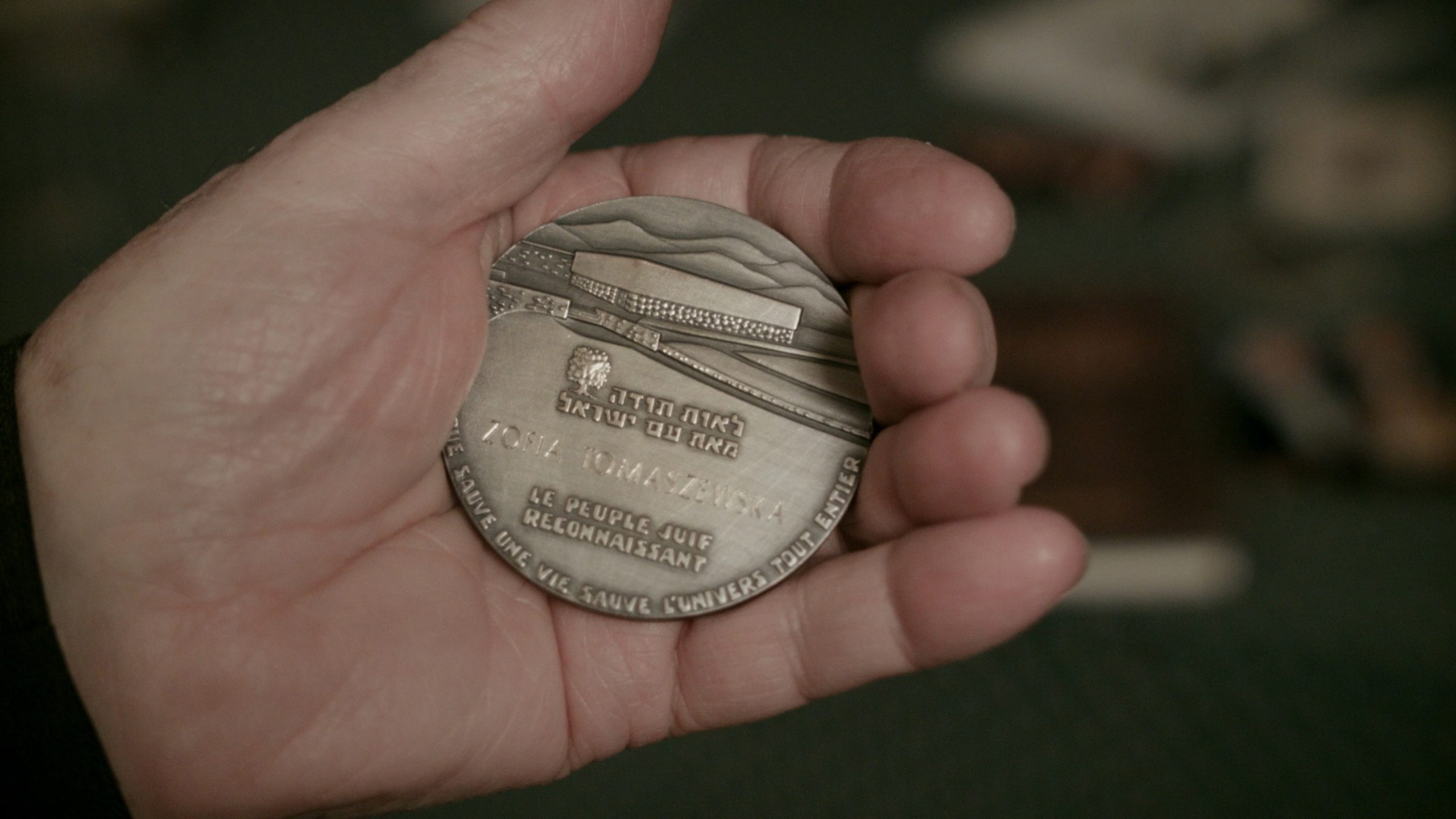
The Righteous Among the Nations Medal for Zofia Tomaszewska, awarded by the Yad Vashem Institute in Jerusalem in 2007

Colour photo of a hand holding the round Medal of the Righteous Among the Nations for Zofia Tomaszewska. It was awarded by the Yad Vashem Institute in Jerusalem in 2007. The inscriptions on the medal are in Polish and Hebrew.
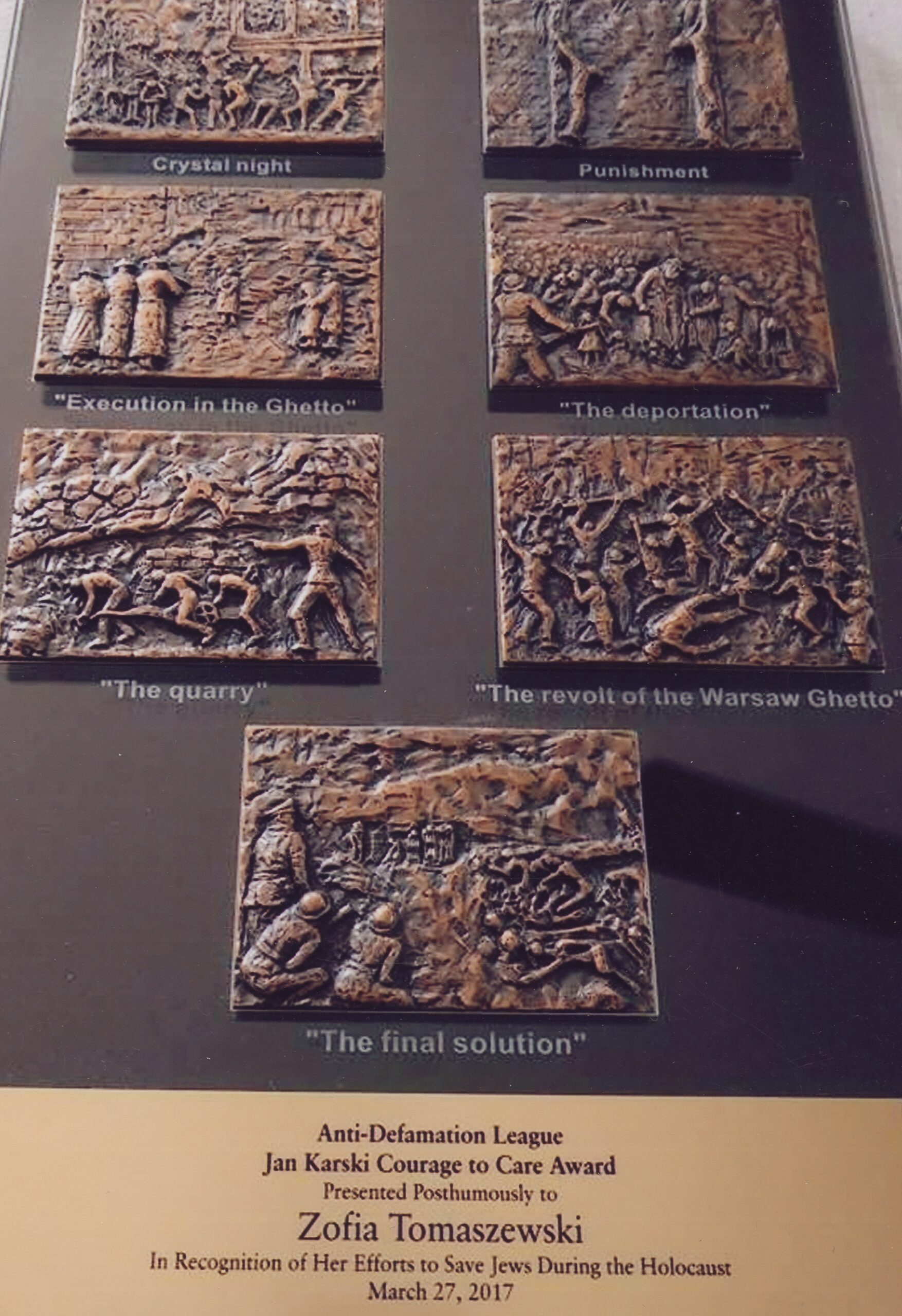
Jan Karski Courage to Care Award for Zofia Tomaszewska bestowed by the Anti-Defamation League in the United States in 2017 for saving the Rubach family

The photo shows the Jan Karski Medal awarded to Zofia Tomaszewska by the Anti-Defamation League in the United States in 2017 for saving the Rubach family. It consists of 7 bronze rectangles depicting various scenes, such as Kristallnacht and the Warsaw Ghetto Uprising.
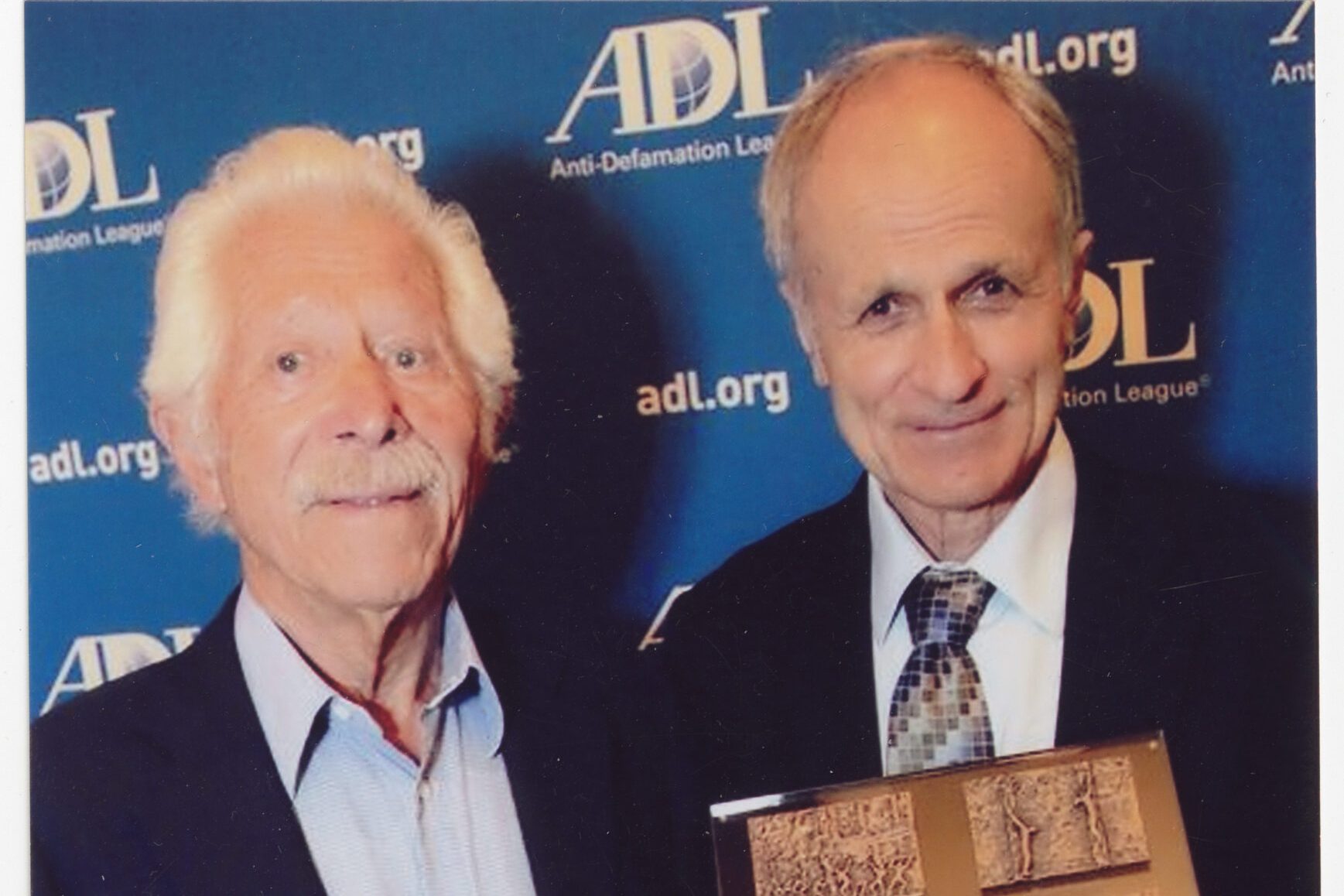
Leon Rubach and Wojciech Tomaszewski receive the Jan Karski Courage to Care Award for Zofia Tomaszewska, USA, 2017

Colour photo of Leon Rubach and Wojciech Tomaszewski receiving the Jan Karski decoration for Zofia Tomaszewska. Rubach is about seventy years old, dressed in a navy blue suit and light blue shirt. Tomaszewski is standing next to him, his eyes deeply set. He is dressed in a black jacket, coloured tie and cream-coloured pants. In his hands he holds a decoration, which is gold in colour, and on it are bronze rectangles depicting various scenes, such as Kristallnacht and the Warsaw Ghetto Uprising.
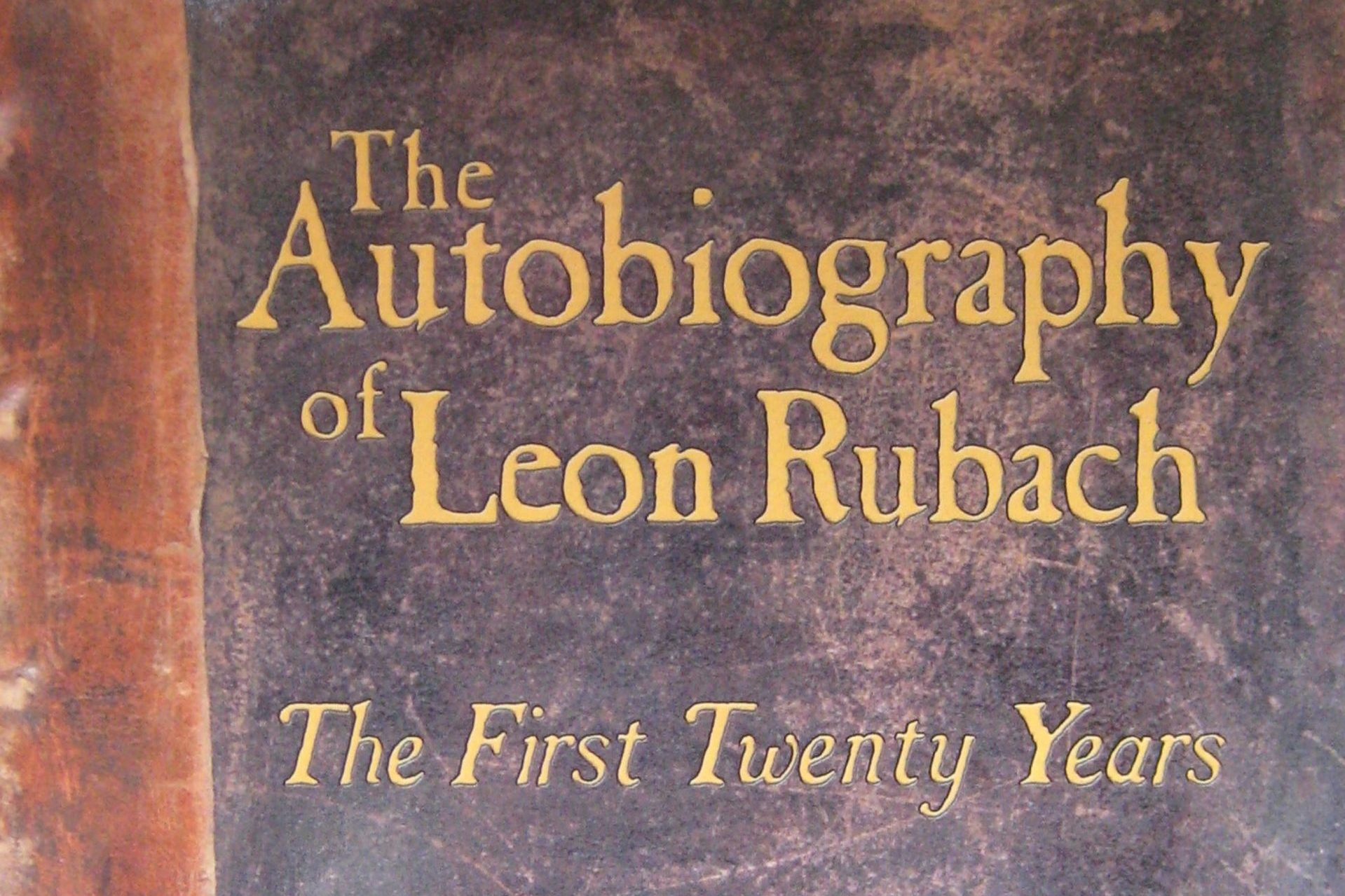
The cover of his memoirs with a dedication by Leon (Ula) Rubach who was saved by Zofia Tomaszewska. Leon Rubach „The Autobiography of Leon Rubach. The First Twenty Years”, New Jersey 2009.

Okładka książki z dedykacją Leona Rubacha ocalonego przez Zofię Tomaszewską. Na okładce tytuł: “The Autobiography of Leon Rubach, The First Twenty Years” oraz imię i nazwisko autora.

